engine coolant CHEVROLET TRACKER 1998 1.G Owners Manual
[x] Cancel search | Manufacturer: CHEVROLET, Model Year: 1998, Model line: TRACKER, Model: CHEVROLET TRACKER 1998 1.GPages: 386, PDF Size: 21.17 MB
Page 6 of 386
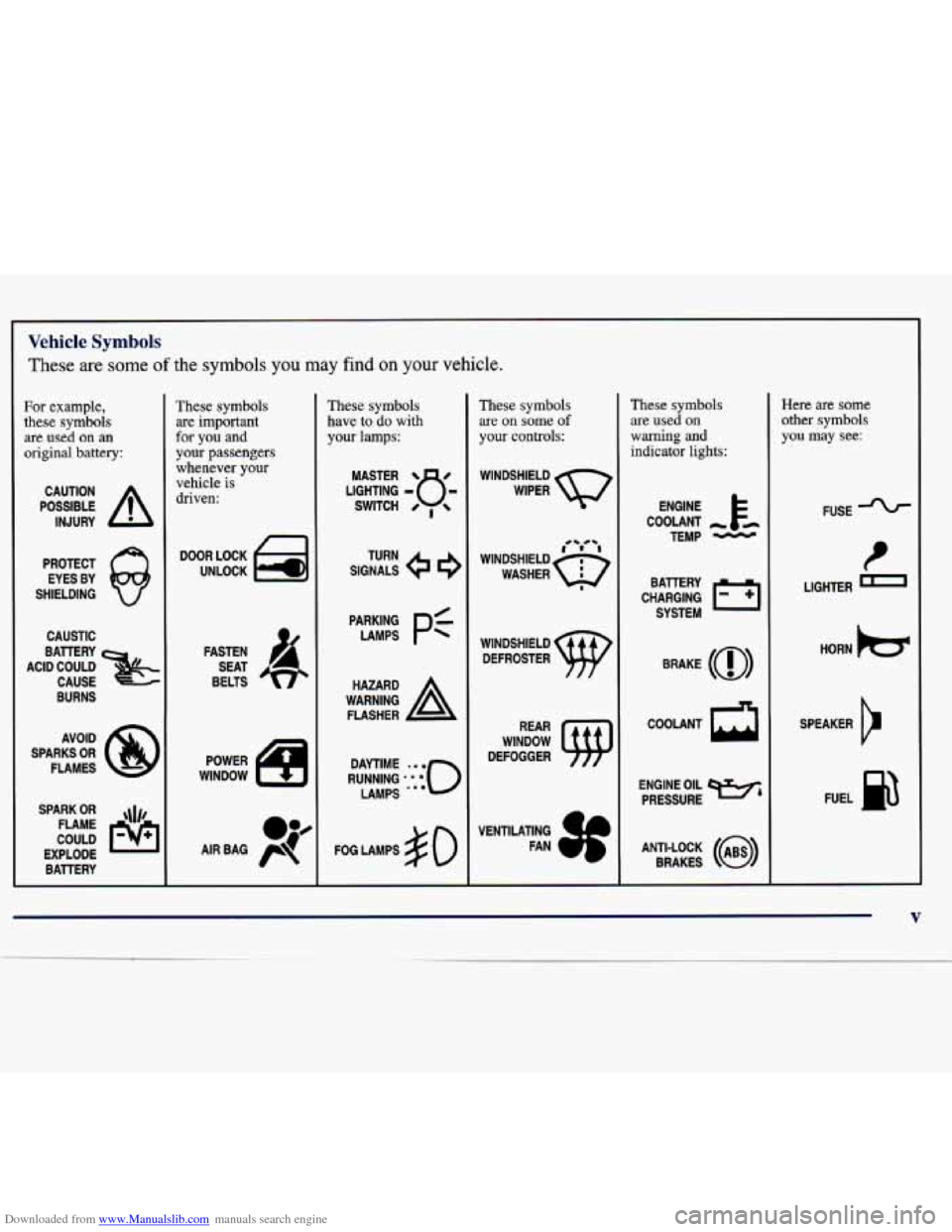
Downloaded from www.Manualslib.com manuals search engine L
Vehicle Symbols
These are some of the symbols you may find on your vehicle.
For example,
these symbols are used on
an
original battery:
POSSIBLE A
CAUTION
INJURY
PROTECT EYES BY
SHIELDING
CAUSTIC
BURNS
SPARK
OR ,111,
COULD FLAME
EXPLODE BATTERY
These symbols are important
for
you and
your passengers whenever your
vehicle
is
driven:
DOOR LOCK
UNLOCK
FASTEN SEAT
BELTS
These symbols
have
to do with
your lamps:
SIGNALS e
TURN
FOG LAMPS
$0
These symbols
are on some of
your controls:
WINDSHIELD WIPER
WINDSHIELD DEFROSTER
WINDOW
DEFOGGER
REAR
VENTILATING
FAN
These symbols
are used on
warning and
indicator lights:
COOLANT
TEMP
-
CHARGING I-1
BAlTERY
SYSTEM
BRAKE
(a)
ENGINE OIL e,
PRESSURE
ANTI-LOCK
(@)
BRAKES
Here are some
other symbols
you may see:
FUSE -%-
P
LIGHTER u
HORN )tr
SPEAKER
cz
FUEL B
V
Page 121 of 386
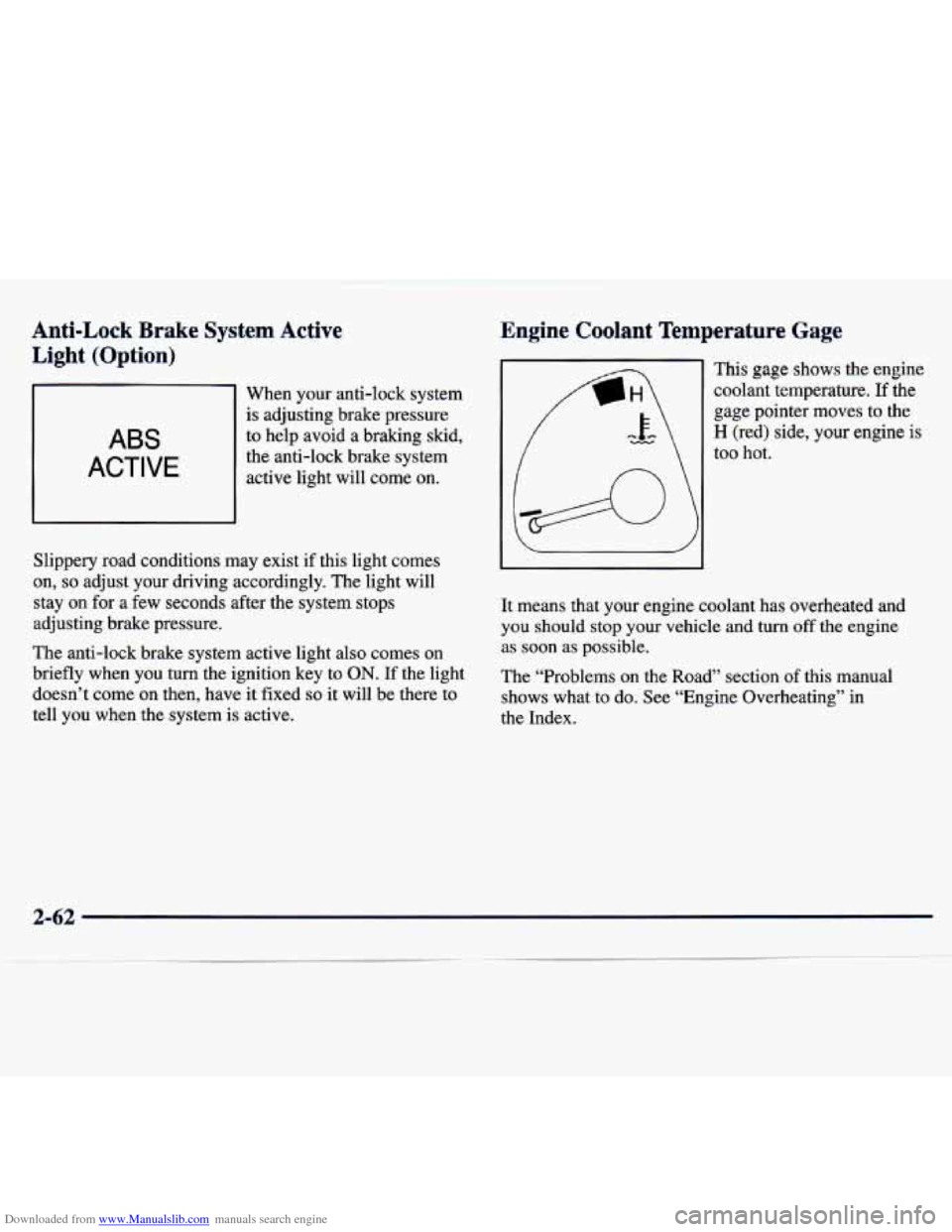
Downloaded from www.Manualslib.com manuals search engine Anti-Lock Brake System Active
Light (Option)
~
._.a
Engine Coolant Temperature Gage
ABS
ACTIVE
r 1
When your anti-lock system is adjusting brake pressure
to help avoid a braking skid,
the anti-lock brake system active light will come on.
Slippery road conditions may exist if this light comes
on,
so adjust your driving accordingly. The light will
stay on for a few seconds after the system stops
adjusting brake pressure.
The anti-lock brake system active light also comes on
briefly when you turn the ignition key to
ON. If the light
doesn’t come on then, have it fixed
so it will be there to
tell you when the system is active. This
gage shows the engine
coolant temperature. If the
gage pointer moves to the
H (red) side, your engine is
too hot.
It means that your engine coolant has overheated and
you should stop your vehicle and
turn off the engine
as soon as possible.
The “Problems on the Road” section of this manual
shows what to do. See “Engine Overheating’’ in
the Index.
2-62
Page 213 of 386
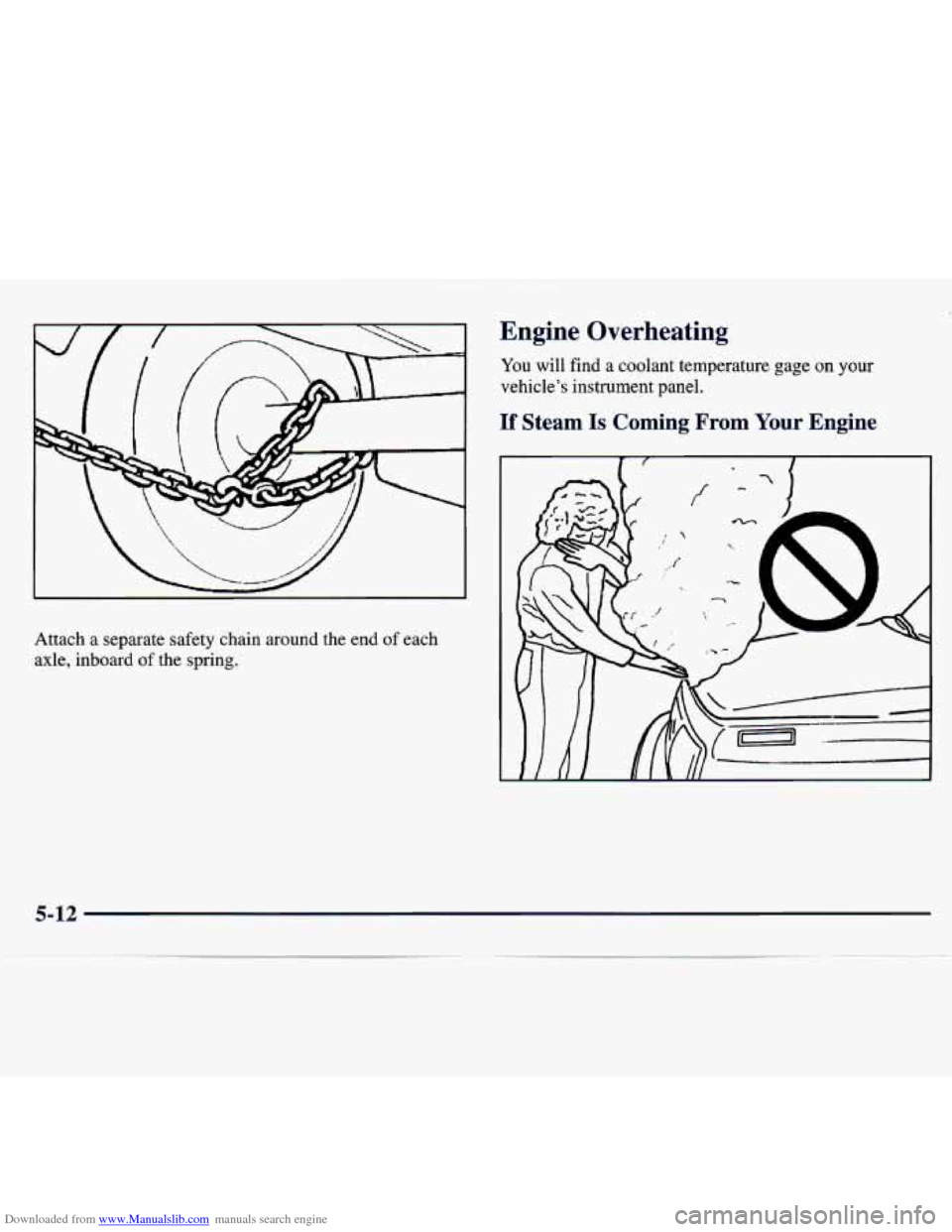
Downloaded from www.Manualslib.com manuals search engine I I I /
Attach a separate safety chain around the end
of each
axle, inboard of the spring.
Engine Overheating
You will find a coolant temperature gage on your
vehicle’s instrument panel.
If Steam Is Coming From Your Engine
5-12
Page 214 of 386

Downloaded from www.Manualslib.com manuals search engine Steam from an overheated engine can burn you
badly, even if you just open the hood. Stay
away
from the engine if you see or hear steam coming
from
it. Just turn it off and get everyone away
from the vehicle until
it cools down. Wait until
there
is no sign of steam or coolant before you
open the hood.
If you keep driving when your engine is
overheated, the liquids in it can catch fire. You or
others could be badly burned. Stop your engine if
it overheats, and get out of the vehicle until the
engine is cool.
~~ ~ ~~ ~ ~ ~ ~ ~ ~~~~~~ ~~~~~~____
If your engine catches fire because you keep
driving with no coolant, your vehicle can be
badly damaged. The costly repairs would not be
covered by your warranty.
If No Steam Is Coming From Your Engine
If you get the overheat warning but see or hear no
steam, the problem may not be too serious. Sometimes
the engine can get a little too hot when you:
Climb a long hill on a hot day.
0 Stop after high-speed driving.
Idle for long periods in traffic.
Tow a trailer.
5-13
Page 215 of 386
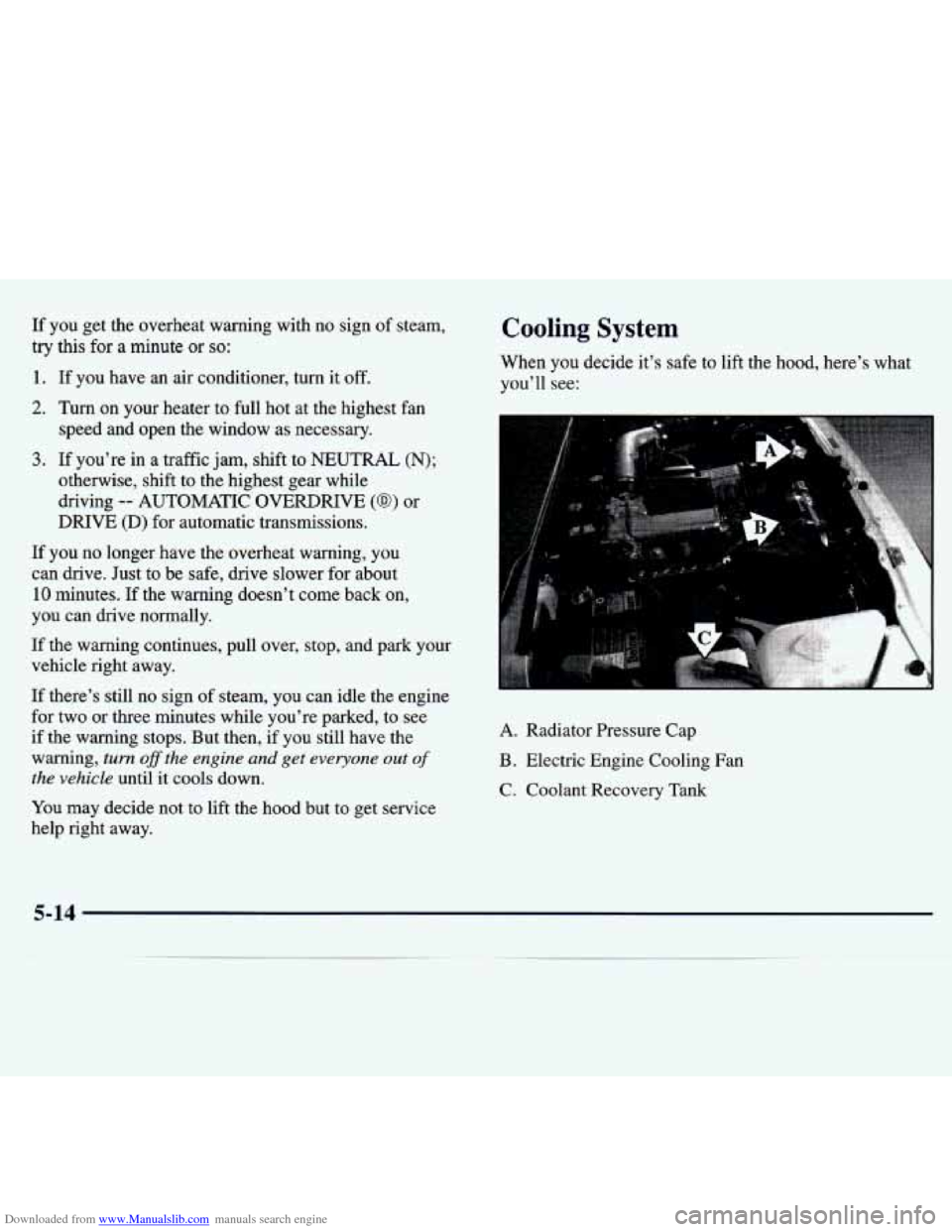
Downloaded from www.Manualslib.com manuals search engine If you get the overheat warning with no sign of steam,
try this for a minute or so:
1. If you have an air conditioner, turn it off.
2. Turn on your heater to full hot at the highest fan
speed and open the window as necessary.
3. If you’re in a traffic jam, shift to NEUTRAL (N);
otherwise, shift to the highest gear while
driving
-- AUTOMATIC OVERDRIVE (a) or
DRIVE (D) for automatic transmissions.
If you no longer have the overheat warning, you
can drive. Just to be safe, drive slower for about
10 minutes. If the warning doesn’t come back on,
you can drive normally.
If the warning continues, pull over, stop, and park your
vehicle right away.
If there’s still no sign of steam, you can idle the engine
for two or three minutes while you’re parked, to see
if the warning stops. But then,
if you still have the
warning,
turn ojjfthe engine and get everyone out of
the vehicle until it cools down.
You may decide not to lift the hood but to get service
help right away.
Cooling System
When you decide it’s safe to lift the hood, here’s what \
you’ll see:
A. Radiator Pressure Cap
B. Electric Engine Cooling Fan
C. Coolant Recovery Tank
5-14
Page 216 of 386
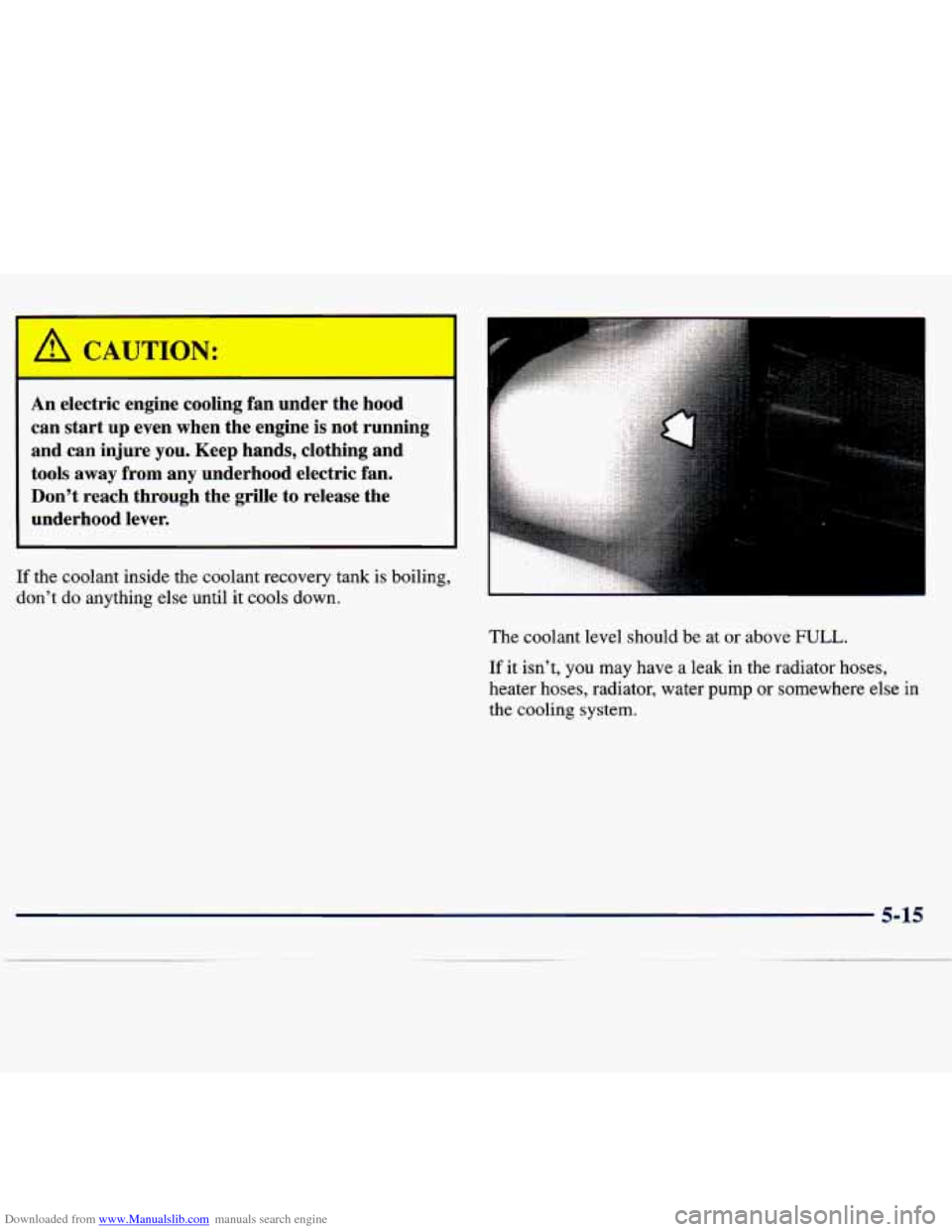
Downloaded from www.Manualslib.com manuals search engine I
An electric engine cooling fan under the hood
can start
up even when the engine is not running
and can injure
you. Keep hands, clothing and
tools away from any underhood electric fan.
Don’t reach through the grille
to release the
underhood lever.
If the coolant inside the coolant recovery tank is boiling,
don’t
do anything else until it cools down.
The coolant level should be at
or above FULL.
If it isn’t, you may have a leak in the radiator hoses,
heater hoses, radiator, water pump or somewhere else in
the cooling system.
5-15
Page 217 of 386
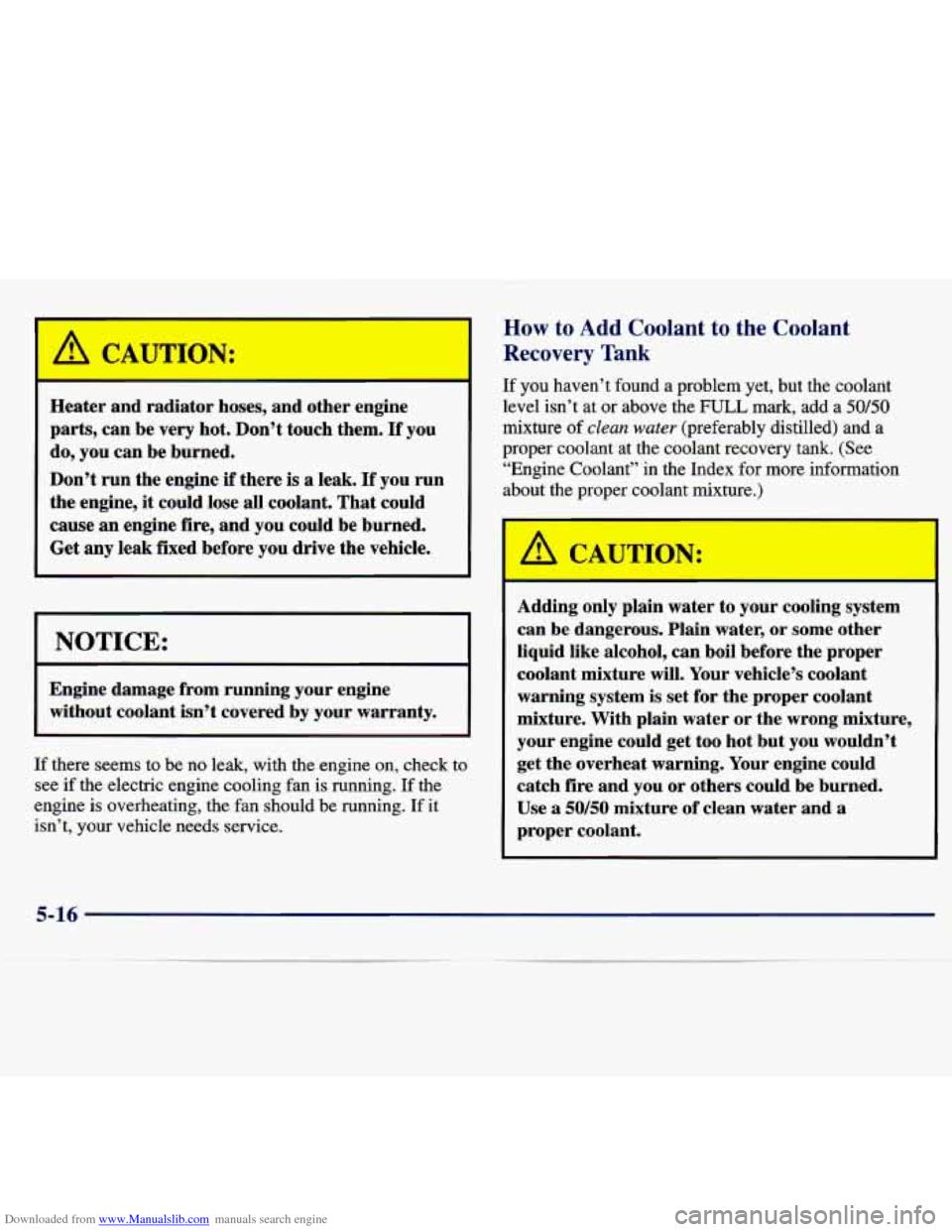
Downloaded from www.Manualslib.com manuals search engine I A
A C ,U ION:
Heater and radiator hoses, and other engine
parts, can be
very hot. Don’t touch them. If you
do, you can be burned.
Don’t run the engine if there is
a leak. If you run
the engine, it could lose all coolant. That could
cause an engine fire, and you could be burned.
Get
any leak fixed before you drive the vehicle.
NOTICE:
Engine damage from running your engine
without coolant isn’t covered by your warranty.
If there seems to be no leak, with the engine on, check to
see if the electric engine cooling fan
is running. If the
engine is overheating, the fan should be running. If it
isn’t, your vehicle needs service.
How to Add Coolant to the Coolant
Recovery Tank
If you haven’t found a problem yet, but the coolant
level isn’t at or above the
FULL mark, add a 50/50
mixture of clean water (preferably distilled) and a
proper coolant at the coolant recovery tank. (See
“Engine Coolant” in the Index for more information
about
the proper coolant mixture.)
Adding only plain water
to your cooling system
can be dangerous. Plain water, or
some other
liquid like alcohol, can boil before the proper
coolant mixture will. Your vehicle’s coolant
warning system is set for the proper coolant
mixture. With plain water or the wrong mixture,
your engine could get too hot but you wouldn’t
get the overheat warning. Your engine could
catch fire and you or others could be burned.
Use a 50/50 mixture of clean water and a
proper coolant.
5-16
Page 218 of 386

Downloaded from www.Manualslib.com manuals search engine NOTICE:
In cold weather, water can freeze and crack
the engine, radiator, heater core and other parts.
Use the recommended coolant and the proper
coolant mixture.
A CAUT,JN:
You can be burned if you spill coolant on hot
engine parts. Coolant contains ethylene glycol
and
it will burn if the engine parts are hot
enough. Don’t spill coolant on
a hot engine.
When the coolant in the coolant recovery tank
is at or
above the
FULL mark, start your vehicle.
If the overheat warning continues, there’s one more
thing you can try.
You can add the proper coolant
mixture directly
to the radiator, but be sure the cooling
system is cool before you do it.
5-17
.
Page 220 of 386
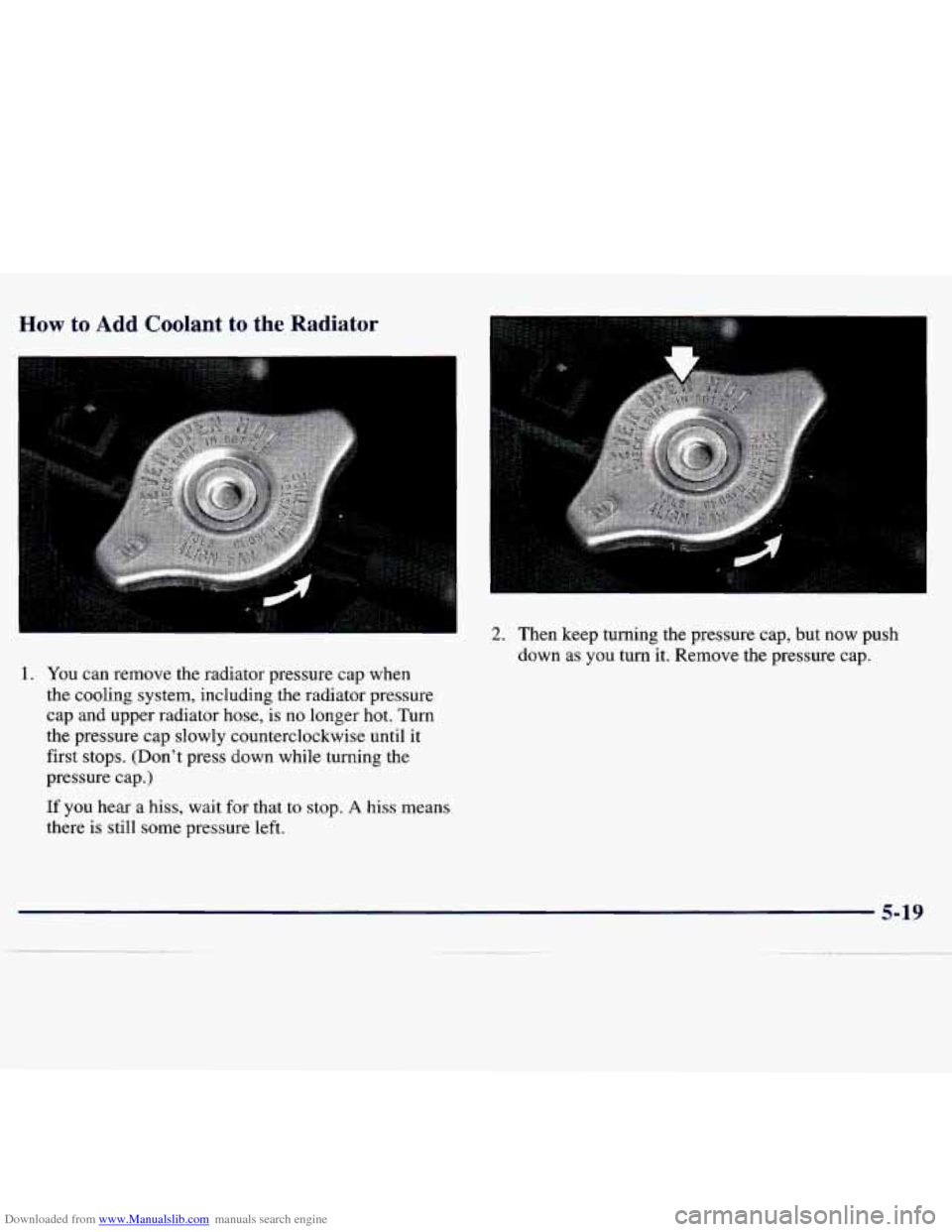
Downloaded from www.Manualslib.com manuals search engine How to Add Coolant to the Radiator
I
1. You can remove the radiator pressure cap when
the cooling system, including the radiator pressure
cap and upper radiator hose, is no longer hot. Turn
the pressure cap slowly counterclockwise until it
first stops. (Don’t press down while turning the
pressure cap.)
If you hear a hiss, wait for that to stop.
A hiss means
there is still some pressure left.
2. Then keep turning the pressure cap, but now push
down as you turn it. Remove the pressure cap.
5-19
Page 221 of 386
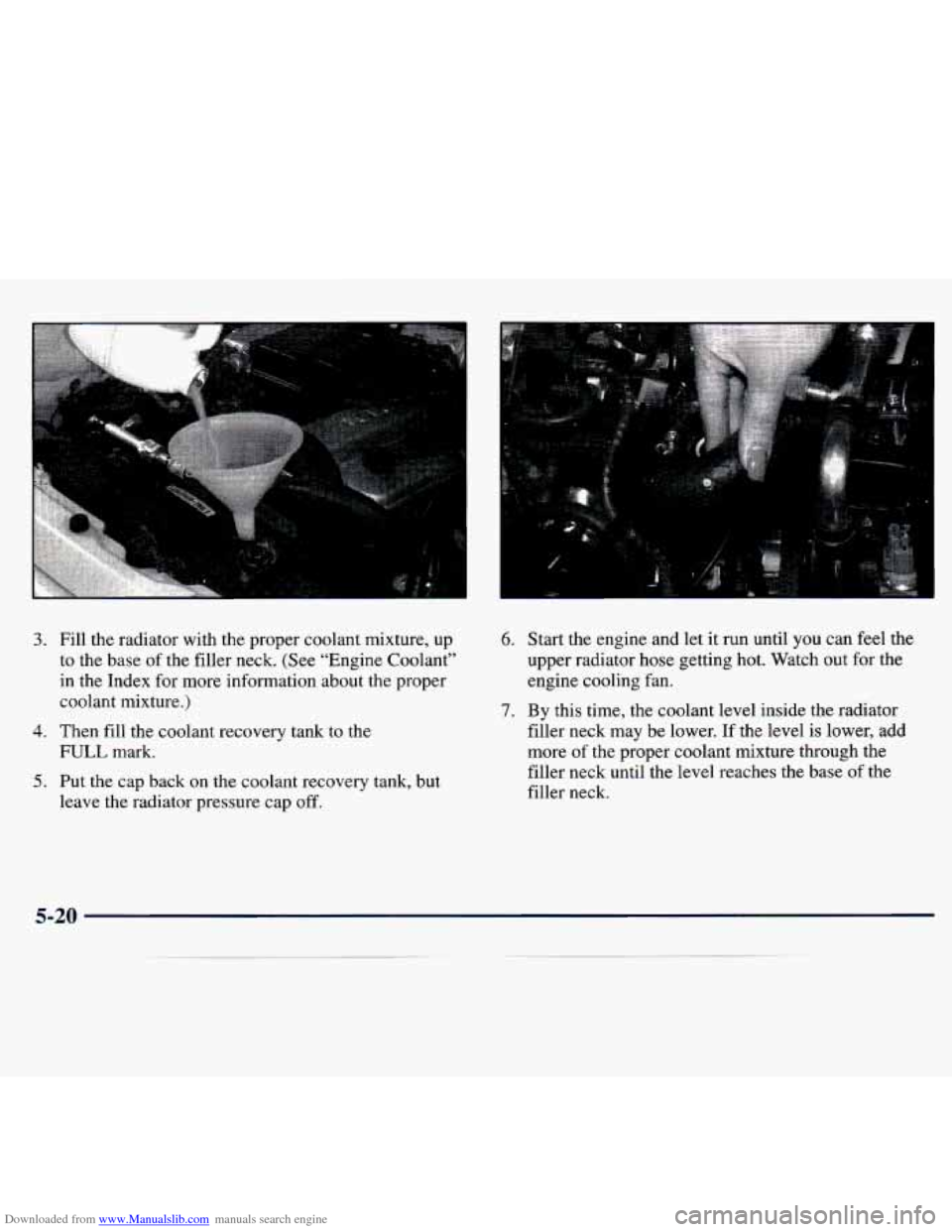
Downloaded from www.Manualslib.com manuals search engine 3. Fill the radiator with the proper coolant mixture, up
to the base of the filler neck. (See “Engine Coolant” in the Index for more information about the proper
coolant mixture.)
4. Then fill the coolant recovery tank to the
FULL mark.
5. Put the cap back on the coolant recovery tank, but
leave the radiator pressure cap off.
6. Start the engine and let it run until you can feel the
upper radiator hose getting hot. Watch out for the
engine cooling fan.
7. By this time, the coolant level inside the radiator
filler neck may be lower. If the level is lower, add
more of the proper coolant mixture through the
filler neck until the level reaches the base
of the
filler neck.
5-20